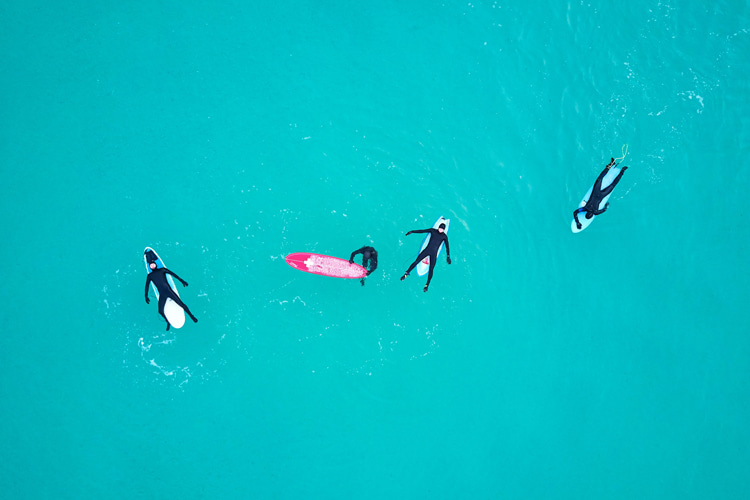Environmental education should be a core part of any surf school's curriculum when teaching beginners how to ride a wave.
Typically, surf lessons focus on surfing "fundamentals," which include paddling, standing up, riding the board in the white water, and sometimes falling off safely.
Yet this narrow-minded view of the "fundamentals" of surfing leaves out key competencies for new learners.
Surfing as a sport is intrinsically tied to the ocean and the environment.
For this reason, surf schools and instructors must go beyond teaching basic techniques and work to include environmental education in their lessons.
This means teaching students about ocean ecosystems and biodiversity, human impact on marine resources, and both individual and societal conservation strategies.
Personally, I have worked as a surf instructor for ten years, starting with UCLA's Marina Aquatic Center and later with a variety of international tour operators and surf schools.
In my lessons, I always give tidbits about the coastline, how waves work, and model eco-friendly behavior, but I never had the time nor the agency to delve into anything deeper than that.
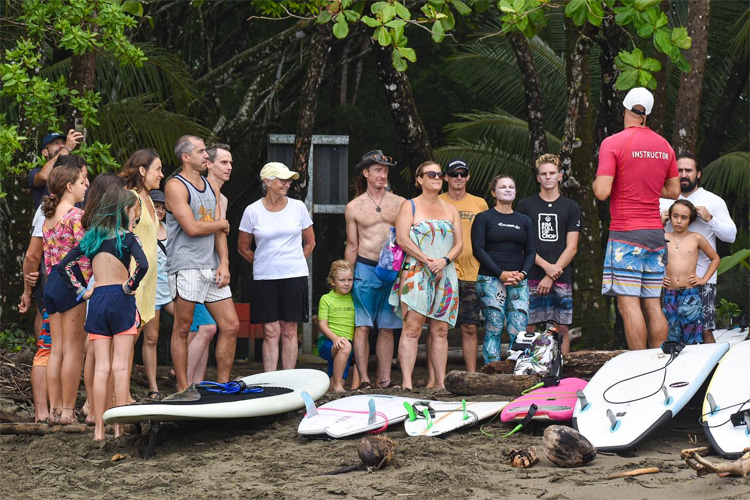
The Private Role
After a period in the Peace Corps teaching environmental education in Nicaragua, I moved to Costa Rica, where I began to appreciate the value of businesses doing work that might be traditionally targeted by a non-profit.
Businesses, I believe, have a reach and potential impact that many NGOs can only dream of.
That's when I came to Bodhi Surf + Yoga, a surf retreat in Costa Rica, trying to use their business for good by inspiring their guests to live more sustainably through surfing, yoga, nature immersion, and community engagement.
At Bodhi Surf + Yoga, we believe that the role of a surf instructor should be taken more seriously than it commonly is, particularly in tourist hotspots around the world.
As teachers and coaches, we have a special role in communicating the value of surfing as a force for good and how our day-to-day actions can impact it.
The goal of teaching people to surf should be not only to get them to stand on their board but also to stand up for the ocean.
Surf schools and instructors have a unique opportunity to inspire newcomers to the surf world to start off on the right foot - literally and figuratively - to preserve our big blue playing field for generations to come.
For surfers, the ocean isn't a distant idea - it's our home, our church, our therapist, our everything.
Therefore, the purpose of surf schools should be to teach and inspire ocean stewardship so that every new surfer goes home with a responsibility to protect the ocean.
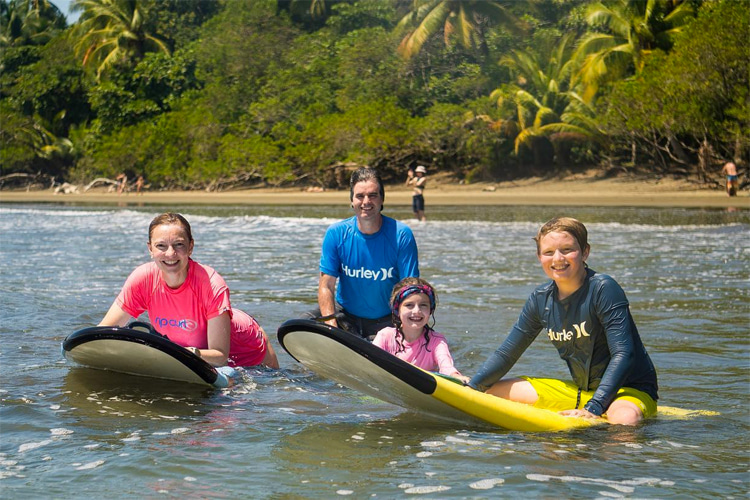
The Importance of Environmental Education
Through education, surf students can better understand the interconnectivity of human actions and their impact on the planet.
This knowledge empowers individuals to make informed decisions and take responsible actions toward mitigating environmental issues.
Some of the issues surf schools are uniquely situated to create awareness about are:
- Plastic pollution;
- Agricultural run-off;
- Algal blooms;
- Loss of biodiversity;
- Effects of climate change;
- Coastal resource depletion or mismanagement;
These topics can and should include problems and viable solutions or remedies.
The specific topic of each lesson should be relevant to the beach's location and the surf instructor's knowledge or passion.
Environmental education during a surf lesson fosters stewardship by nurturing a sense of identity, responsibility, and ownership toward the ocean.
Incorporating new surfers into the surf world is an incredible opportunity for surf schools to play a role in growing a culture of sustainability and conservation within surfing as the sport continues to grow.
In fact, many surfers already tend to become people with deep respect and appreciation towards the ocean - but it often takes many years to develop that connection naturally.
Surf schools can jumpstart this process with a focused, concise, environmentally-focused curriculum.
This type of education should focus on equipping individuals with the knowledge to become active agents of change in their communities.
It can do this simply by inspiring a sense of curiosity and wonder about the environment or directly educating them about specific or local environmental issues and encouraging them to get involved.
At a minimum, surf schools can empower students to open their eyes and think critically about the state of the natural world.
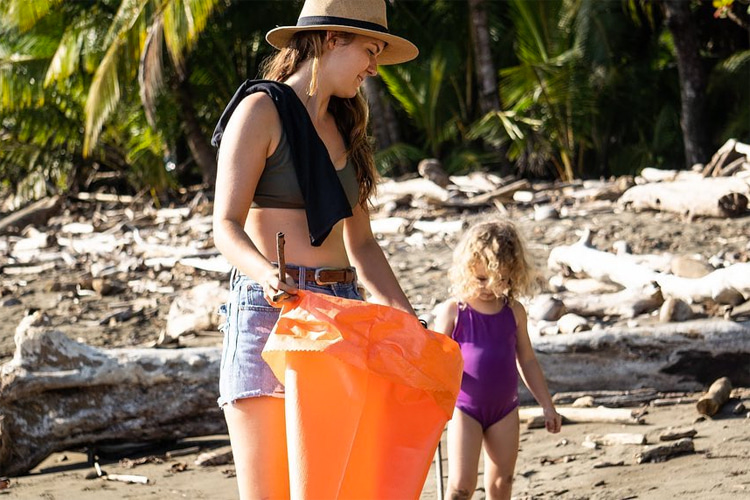
The Role of Surf Schools
Surf schools are uniquely situated to promote environmental education for several reasons.
- Surf lessons often occur in highly impacted tourist areas where consumption and environmental degradation run rampant;
- People who opt-in for surf lessons may have little previous experience with the ocean;
- Participants in a lesson already expect to learn something from their instructors;
- Surf instructors are some of the most passionate and observant coaches in the sports world, and their work-site well-being is directly related to ocean and beach health;
- The popularity of surf hotels and surf retreats focused on high-performance surfing or surf travel is growing exponentially, and simultaneously, the prevalence of wave pools is increasing, causing the sport to grow rapidly;
- Surf culture is mainstream and penetrates the economy globally, making consumers of the surf industry highly impactful;
How to Incorporate Ecological Learning Into a Surf Lesson
Before the Lesson
- Provide pre-lesson materials: Surf schools can share educational materials such as articles or videos focusing on environmental topics. These materials can be sent via email or made available on the surf school's website or social media platforms.
- Conduct pre-lesson discussions: Instructors can start conversations with students before the lesson about environmental topics. They can talk about the importance of cleaning up after themselves, picking up trash, respecting wildlife, using reef-safe sunscreen, etc. This helps students understand the relevance of environmental issues in the context of surfing.
During the Lesson
- Incorporate environmental information: Instructors can present information about the local marine environment, such as the types of marine life present, the varying marine ecosystems, and coastal ecology. This can be done during warm-up exercises, in-water instruction, or during breaks between surfing sessions.
- Practice responsible surfing: Instructors can also set an example by following best practices such as not littering, promoting reef-safe sunscreen, avoiding damage to coral reefs, and respecting local marine life. This also includes teaching Leave No Trace principles and reminding students not to take shells or feed the wildlife.
After the Lesson
- Post-lesson debriefs: After the surf lesson, instructors can promote a conversation with students to reflect on the environmental aspects of the lesson. They can discuss the importance of protecting the ocean, the impact of human activities on marine ecosystems, and how students can take action to support environmental conservation efforts.
- Provide resources for further learning: Surf schools can provide students with additional resources such as books or websites. They can also share information about local eco-driven organizations or initiatives that students could get involved with to support marine conservation efforts.
- Encourage ongoing environmental action: This can include participating in beach clean-ups, advocating for the reduction of single-use plastic consumption, or spreading awareness about environmental issues among their peers.
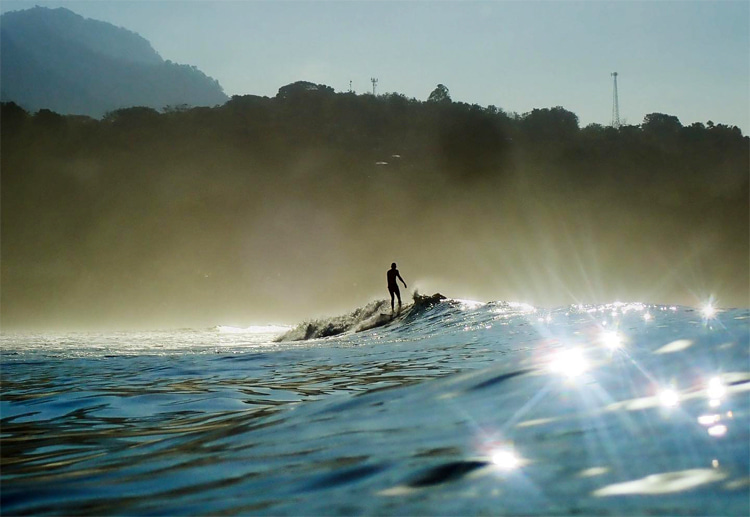
What Environmental Topics Should Instructors Share?
Below are some topics that can be elaborated on or incorporated into surf lessons and surf curriculum, whether it's a one-day surf clinic or a five-day surf instructor training.
1. Ocean Ecosystems and Biodiversity
- Understanding diverse marine ecosystems;
- Comprehending ocean waves;
- Learning about local flora and fauna in the marine environment;
- Importance of biodiversity in ocean health;
- Understanding bathymetry and coastal ecology;
- Knowing how to read a surf report;
2. History of Surfing
- History of surfing as a spiritual practice;
- Types of surfboard core materials and their evolution over time;
- History of surf crafts for subsistence fishing;
- Stories of surf advocacy and environmentalism;
3. Human Impact on Oceans
- Effects of plastic pollution on marine life;
- How fertilizers and pesticides end up in marine zones;
- Overfishing and commercial fishing;
- Climate change and its effect on marine ecosystems;
- Habitat destruction;
- Impact of tourism and recreational activities;
- Invasive species;
- Noise and light pollution;
4. Importance of Protecting the Ocean
- Surfer's responsibility to preserve waves;
- Need for blue spaces for physical health, longevity, and mental health;
- Ways to limit plastic pollution;
- Ways to reduce wasteful consumption;
- Further reading materials or ways to get involved;
- Ongoing sustainability efforts by the surf school;
- Local conservation campaigns;
- Global conservation efforts;
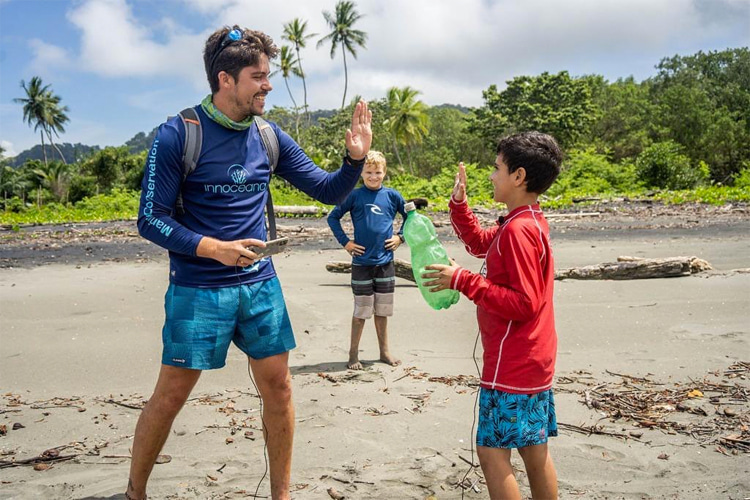
Common Challenges With New Surfers
Teaching ocean conservation during a surf lesson can come with several challenges. Some of these might include:
- Time constraints: In some settings, such as tourist destinations, instructors may only have a limited amount of time with students, who may be drop-ins or on sightseeing vacations. This can make it difficult to cover different topics and engage students meaningfully.
- Students may have little knowledge about the ocean: Some may view the ocean as separate from their daily lives or live far from the beach and, therefore, not fully grasp the significance of learning about ocean conservation.
- Ocean ecosystems are complex: Some educators may struggle to grasp and then explain scientific concepts and ecological principles. This requires instructors to simplify complex ideas for students in an accessible and engaging way.
- Limited resources: Access to relevant educational resources, such as up-to-date information, data, and materials, may be limited in some coastal settings. Instructors may not have the local knowledge to teach ocean conservation in a way that is relevant to their surroundings.
- Cultural factors: Cultural beliefs, practices, and socioeconomic factors may influence attitudes and behaviors toward ocean conservation. Examples include buying popular sunscreen brands (that damage reefs) or taking seashells or sea rocks home as souvenirs or for collections. Instructors and schools must promote ocean conservation in a culturally sensitive and inclusive manner.
- Keeping it positive: Ocean conservation issues such as pollution, overfishing, habitat destruction, and climate change can evoke strong emotions such as anger or frustration. Educators may struggle to frame these issues positively to facilitate meaningful discussions and promote positive behavior change.
How surf schools will address these challenges depends on their length of program, location, and access to resources.
Creativity may be needed to overcome a lack of resources, for example, by using natural materials on-site or promoting experiential or observational learning.
Surf instructors should be thoroughly trained on lesson material and taught how to present topics in a culturally sensitive and inclusive manner.
Finally, instructors should be encouraged to make the experience overall fun and positive.
For example, as a surf instructor, I like to pick up trash in front of my students to show that it is a surfer's responsibility to keep the beach clean.
This can serve as a powerful example for participants to emulate and reinforce the importance of responsible practice.
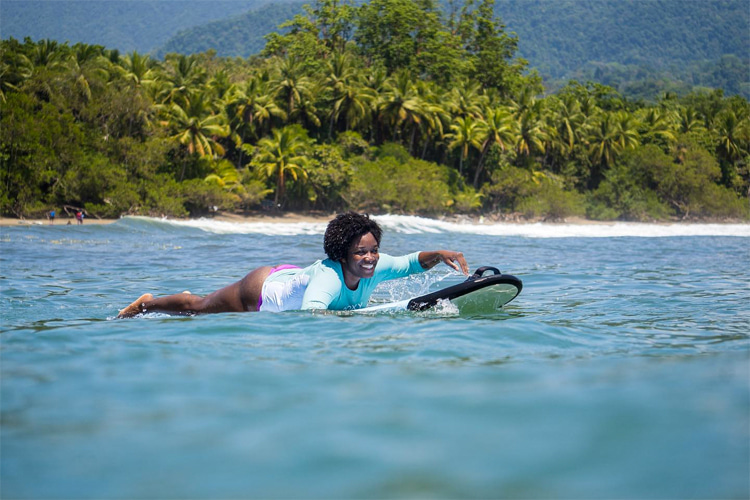
Impact On Surf Curriculum
Environmental education in surf schools can have several potential impacts on the local community where the lesson takes place and in the participant's city as they return home.
The impacts of learning how to surf in an environmentally conscious manner are limitless, but those listed below should serve as a goal when designing a curriculum.
- Enhanced connection with nature: When surfers directly engage with the ocean and marine environments, it fosters a deep connection with nature. As surf instructors, we can further enhance this connection by helping students appreciate the beauty and value of the ocean and nurturing a sense of awe, wonder, and respect toward marine ecosystems.
- Empowerment and agency: Surf schools can empower students to make a positive impact by teaching them how our actions can either harm or protect the ocean and that, as surfers, we are all responsible for reducing our environmental footprint. After their lesson, new surfers should understand their role as ocean stewards.
- Community engagement: Surfers are highly effective ambassadors for environmental awareness and action within their communities. They can influence peers, family, and friends to adopt sustainable behaviors and participate in conservation efforts. Surf schools should encourage their students to participate in local organizations on ocean conservation issues.
Measuring Success
Measuring the success of educational programs in surf schools can take time and effort.
Here are some ideas on how to measure a program's effectiveness:
- Pre- and post-assessments: Surf schools can identify changes in the knowledge and attitudes of participants before and after the lessons. They can do this through informal conversations and questions with the goal of evaluating the effectiveness of the curriculum in enhancing awareness and understanding of environmental issues.
- Observations and reflections: Similar to the previous point, simply observing and reflecting on learners' beliefs, behaviors, and actions during surf lessons can provide insight into the program's impact on learners' behaviors in real-world settings.
- Success stories: Documenting case studies or success stories of surf school participants who have taken action or made positive changes in their behaviors towards ocean conservation can also serve as an example of the program's impact.
- Partnerships and collaborations: Collaborating with local environmental organizations, researchers, or other stakeholders can provide a more comprehensive and robust assessment of the program's impact on the broader community. These institutions can offer more resources to monitor and evaluate any long-term changes in the area.
Generate a Positive Impact
Surfing is closely connected to the ocean and the environment, and surf schools have a unique opportunity to educate and inspire surfers to become environmentally-conscious individuals.
By doing this, surf schools can foster a sense of stewardship and promote sustainable practices among new surfers.
Incorporating environmental lessons can also positively impact the surfing community and more significant efforts toward ocean conservation.
Surf instructors and schools should leverage their unique opportunity to inspire pro-environmental behavior change.
This requires some instructor guidance to lead clients through a few stages: fear of the ocean, respect, love, and finally, responsibility.
We must take advantage of our influential roles to create more surfers and ocean advocates.
It's easy getting people to their feet.
The real work begins when surf schools get people to minimize their ecological footprint.
Not just to stand on a board but to stand up for Mother Nature.
Words by Carly Stoenner | Surf Instructor at Bodhi Surf + Yoga, Author, NOLS Wilderness First Responder, Former Peace Corps Nicaragua Volunteer, and B.A. in Political Science and Environmental Systems and Society from the University of California, Los Angeles
